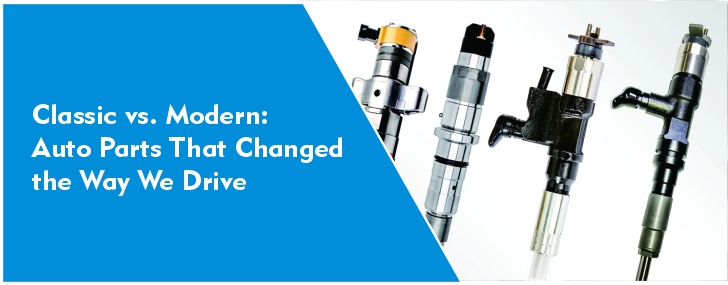
Classic vs. Modern: Auto Parts That Changed the Way We Drive
Everything is changed for the word “Car” or “Automobile” in modern times. Car’s were just a mode of transport in the beginning, but as the time changed so is their purpose. Cars with modern auto parts offer more than just transport, they offer safety, status & adventure all packed in one.
In this article we will talk about difference between classic vs. modern auto parts and how they have changed today’s vehicles. The given article is provided to you by Car engine Guru, sot that regular people can become more aware.
Engines – From Pure Mechanics to Electronic Control
In classic cars, engines were straightforward. Carburetors were used to mix air and fuel in them. Everything was visible, mechanical, and fixable in your own garage. No sensors, no software—just timing, spark, and air-fuel balance.
Modern engines depend upon EFI’s, electronic fuel injection systems, operated by electronic control unit. This is a computer unit that measures air intake, temperature & fuel pressure. It controls everything for better fuel economy, fewer emissions, and more power. But it also means fewer things you can fix without diagnostic tools.
That’s the real gap in Classic vs Modern Auto Parts. The old engines let drivers get their hands dirty. Modern ones run smarter, cleaner, but depend heavily on electronics. For some, that’s progress. For others, it’s the end of the DIY era.
Braking Systems – Simplicity vs. Safety Tech
The earlier type of brakes used was all hydraulic. You stepped on the pedal, and the brake fluid forced the pads to the rotors. That was it. No computers or sensors. It was good, not necessarily in hard conditions. It was usual to lock wheels when in panic stops particularly when on wet roads.
Then there was Anti-lock Braking Systems (ABS) and then there was Electronic Stability Control (ESC). The modern brakes do not simply halt the vehicle, they control the traction, identify skids and automatically merge the braking power. The touch can be not so much mechanical, but it is safer.
Braking has been identified as one of the largest upgrades in modern auto parts as compared to the classic auto parts. You are deprived of some of your old pedal feel, but are confident when it pours, or when there is an emergency stop. Traditional brakes provided an element of control, contemporary brakes provide an element of accuracy.
Steering and Suspension – Strength vs. Comfort.
There is an electric power steering in modern cars. It is easy, light, and smooth particularly when driving in the city. The system will vary the resistance with the speed and conditions. It is a big improvement in convenience, but it removes that unwholesomely road, feel.
Suspension systems have also changed a lot. Old systems were simplistic coil springs and shock absorbers. They were fine but relayed all the bumps and shakes directly to the cabin. In the modern times, there is the use of advanced dampers, stabilizer bars and adaptive systems which adjust the stiffness dynamically.
It is also another place in which Classic vs Modern Auto Parts has a significant divide in the driving style. Classic cars are to be felt at every turn. Modern cars glide. It is a boon-trade-off between uncivilized experience and ease. Most car enthusiasts claim that the ancient suspensions were soulful. They were not ideal, but they were in-your-face.
Electrical Systems – Simple Tech
Classic cars were wired using standard wiring. A few fuses, an alternator, a battery, that was it. Thou might trace with thy eye In each line And Paste with thy finger mend. Light, ignition, radio–All simple circuits.
The current automobiles operate on intricate electrical systems. Everything is going to go through boards of electronic controls including wipers, seats, mirrors and such. Dozens of one another are communicating with the sensors, chips and relays. It is also effective and potent and is also more challenging to trouble shoot.
Here the debate Classic vs Modern Auto Parts comes out in particular. The wiring harnesses of the old ones were easy to follow, though they could appear messy. Newer ones are sanitized, shrinky, and submerged in the software.
Transmission and Drivetrain- Manual vs. Smart Efficiency
They should have been on manual transmissions. You moved gears by yourself, and determined the amount of power to go to the wheels. It was interactive, basic and it imparted practical driving. There were automatic transmission systems that were sporadic and sluggish in older models. They tended to steal performance and consumed excessively of fuel. That’s no longer true.
This is one of those that most divide the drivers in the Classic vs Modern Auto Parts line. New transmissions are also connected out to computers to make impact adjustments to optimize efficiency in real time.
It is another one with raw and refined. One of them is more control; the other is speed and smoothness. No right side–whist such driving you like.
Conclusion:
Each element of the car tells its story. Mechanical components of the vintage automobiles indicate an era when driving was about proficiency and relationship. You reassembled your car when it got out, you could feel it shake, you were able to learn your car like the inside of your jacket.
The modern automobiles reversed the situation. They reason, evolve and safeguard the driver unlike the older machines. In this case in comparing Classic vs Modern Auto Parts; whatever you like best personally is what matters. And if you are need of quality used auto parts then carengineguru.com is one stop shop for you. We are dealing in used auto parts for over a decade now. Visit us at the link given above.
